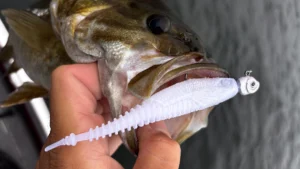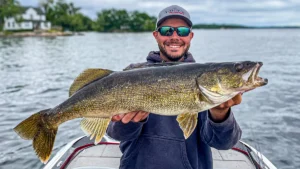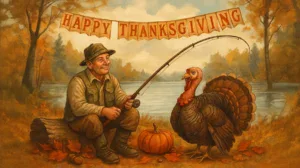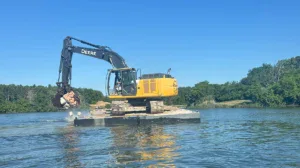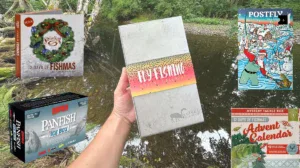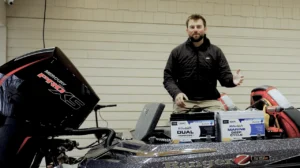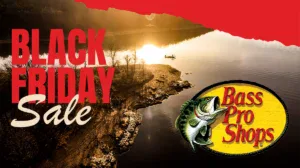You catch fish on most hollow body frogs throughout a fairly broad spectrum of conditions. But you’ll find the more you fish these amphibious imitations, there’s typically a specific frog that will work particularly well given a certain set of circumstances.
Frog fishing can produce some big bites, but they’re often few and far between. Picking the exact right frog for a specific set of conditions can mean a couple more or even a couple dozen-more bites over the course of a day of fishing.
So the goal today is to lay out a few of these specific frogging scenarios and single out the one or two frogs that will produce the best results.

Skipping
If you’ve ever tried to skip a frog, you know they’re not all created equally. Or perhaps you don’t know that and you just gave up on skipping a frog after the first two or three attempts didn’t go the way you anticipated. In fact, a frog is one of the easiest baits of all to skip, as long as you have the right one in your hand.
Here are the two main characteristics to look for when skipping a frog: You want a frog with a little weight to it as well as a frog with a fairly flat bottom. Frogs with deep-V bellies catch the water when you try to skip them. Baits with a flat bottom like the Strike King KVD Sexy Frog and SPRO Bronzeye Poppin’ Frog 60, on the other hand, skip exceptionally well.

Mats
When fishing thick, matted vegetation, you want a frog that has weight to it or even better, a frog to which you can add weight. The heavier the frog, the easier it will be for the fish beneath the mat to track it and eat it.
I learned this lesson the hard way, fishing behind professional angler Randall Tharp over a decade ago. Tharp was catching fish after fish out of a mat on Lake Guntersville; I was in the boat fishing alongside him and not getting any bites at all. He looked at me with a grin and said something along the lines of, “Watch this,” as he sat his frog in the open water beside the boat.
The frog immediately began to sink. He then pulled a handful of split shot weights out of his pocket and proceeded to show me how to insert them into the rear of my frog to add weight to it. I then started to catch fish, as my frog began to dig a little ditch through the scum so that the bass could see it.

Insect hatches
Popping frogs are almost guaranteed to be the best producers around insect hatches. Most insects, like mayflies for example, hatch out in the summer months when the water is warm and food can be scarce up shallow.
A popping frog imitates a bluegill or bream eating the insects. While the bream are distracted with the buffet of bugs along the surface, the bass beneath put on the feedbag as well and explode on the bream.
Insert a bait like the aforementioned SPRO Poppin’ Frog 60 or the Snag Proof Smashmouth Frog and you’ve got a great chance of hooking up with the busting bass.

Shad spawns
Though fish are often boiling along the surface during a shad spawn, the water is often a little cool still and the bass aren’t super interested in exploding on an aggressive topwater like a loud, chugging popping frog or a chaos-creating Whopper Plopper.
But the bass will often eat slower walking-style topwater baits. For the same reasons, a walking-style frog in a shad pattern works well. This more subtle movement from a frog is great for shad spawns and gives you the perfect lure to use when the shad are spawning in vegetation in particular.

Bluegill beds
When bream and bluegill begin to spawn along the shoreline and in the backs of pockets, it’s a great time to move from the more subtle walking-style frogs to the popping frogs. As stated at the onset of this piece, this is one of the instances that you could certainly still catch fish on a walking frog. But swapping to a popping frog is preferred for several reasons.
The main reason, popping frogs create a little more commotion along the surface, which is a good thing when targeting fish around bream beds. One of the drawbacks to this type of fishing is that you’ll need to cover a lot of water at times to come across a bream bed. The added noise and splash of a popping frog draws bass in from greater distances, which makes it easier to cover more water faster than if you were fishing a walking frog instead.

Open-water walking
Open-water walking doesn’t imply that there’s no cover nearby, more so you’re not walking the bait through cover, like a grass mat for instance. You could be out in the wide open in this scenario, or certainly being fish a frog around stumps, docks and down grass edges and it still be considered open-water frogging.
For this style of frogging, especially when the water is a little cooler in the spring and summer, a walking frog like the Scum Frog Launch Frog performs the best. It can be worked extremely slow and requires less aggression from a lethargic bass to come up and slurp it down. This makes walking frogs better baits compared to popping frogs when the water is a little chillier.

In conclusion
There are a lot of frogs to choose from and the overabundance of brands, sizes, styles and colors can make the task of selecting the right frog a little daunting. But there are a few basic ideas you can keep in mind to help ease the anxiety.
Matching the hatch when it comes to color selection is always best and the hook is never something to skimp on. Outside of those two things, look for heavier frogs when fishing super-thick mats, flat-belly frogs when skipping, popping frogs in warmer water around bream and walking frogs in cooler water around shad.
These basic guidelines will get you close to the perfect frog for a particular situation.Then it’ll just take a little time on the water with a frog in your hand to help you really narrow your frog selection down to perfection.




